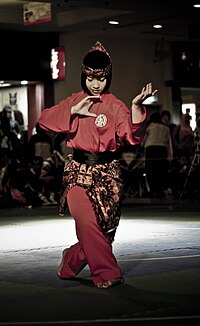 A Malay Singaporean pesilat | |
| Also known as | Seni Persilatan Melayu[1] |
|---|---|
| Focus | self-defence |
| Hardness | Full-contact, semi-contact, light-contact |
| Country of origin | Malay World[2] |
| Olympic sport | No |
| Silat | |
|---|---|
| Country | Malaysia |
| Reference | 01504 |
| Region | Asia and the Pacific |
| Inscription history | |
| Inscription | 2019 (14th session) |
| List | Representative |
Silat Melayu (Jawi: سيلت ملايو), also known as Seni Persilatan Melayu[1] ('art of Malay Silat') or simply Silat, is a combative art of self-defence from the Malay world, that employs langkah ('steps') and jurus ('movements') to ward off or to strike assaults, either with or without weapons. Silat traced its origin to the early days of Malay civilisation, and has since developed into a fine tradition of physical and spiritual training that embodies aspects of traditional Malay attire, performing art and adat. The philosophical foundation of modern Malay Silat is largely based on the Islamic spirituality.[3] Its moves and shapes are rooted from the basis of Silat movements called Bunga Silat, and Silat performances are normally accompanied with Malay drum assembles.[4]
The term Silat is also employed to refer to similar fighting styles in areas with significant Malay cultural influence, in modern-day Brunei, Malaysia, Singapore, Thailand, Philippines, and Vietnam. In Indonesia, the term Pencak Silat, a composite term introduced in the late 1940s,[5][6] deriving from the Sundanese/Javanese word Penca(k) and Malay/Sumatran word Silat,[7] has been used officially since 1973 as an umbrella term of traditional martial arts of Indonesia.[8] In Malay terminology, the term 'Pencak Silat' is also used, but more in referring to the exoteric aspect of the fighting style, in contrast to the esoteric aspect of Silat called Seni Silat ('the art of Silat'). In other words, 'pencak' (fighting) can be regarded as the zahir (outer/exoteric knowledge), whilst seni pertains to the whole of Silat including batin (inner/esoteric knowledge) and zahir. Seni Silat is thus considered to be a deeper level of understanding. Therefore, it is said that each aspect of Silat emanates from seni (art), including both the fighting and the dance aspects.[9]
Regionally, Silat is governed by PERSIB (National Pencak Silat Federation of Brunei Darussalam) in Brunei, PESAKA (National Silat Federation of Malaysia) in Malaysia and PERSISI (Singapore Silat Federation) in Singapore. These governing bodies, together with IPSI (Indonesian Pencak Silat Association), are the founding members of International Pencak Silat Federation (PERSILAT). The sport version of Silat is one of the sports included in the Southeast Asian Games and other region-wide competitions, under the name 'Pencak Silat'. Pencak silat first made its debut in 1987 Southeast Asian Games and 2018 Asian Games, both were held in Indonesia. Silat was recognized as a piece of Intangible Cultural Heritage by UNESCO in 2019.[10]
- ^ a b Department of Heritage Malaysia 2018, p. 1
- ^ Farrer 2009, pp. 26 & 61
- ^ Yahaya Ismail 1989, p. 73
- ^ PSGFM 2016
- ^ Jessicha Valentina 2019
- ^ Paetzold & Mason 2016, p. 7
- ^ Oxford dictionaries, p. Silat
- ^ Harnish & Rasmussen 2011, p. 187
- ^ Farrer 2009, pp. 30–31
- ^ UNESCO 2019